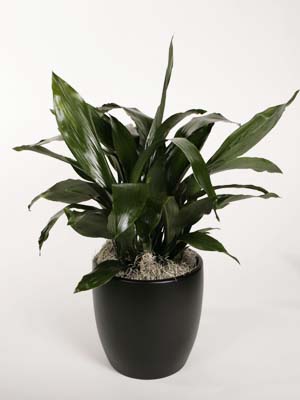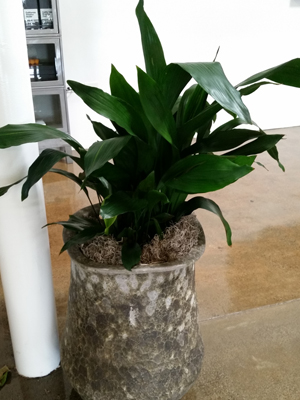Common Name: Cast Iron Plant
Light Needs
Low to bright indirect light
Water Requirements
Water sparingly
Description:
Tall columnar shape up to three feet tall with softer, arching leaves as the plant ages.
Most commonly used varieties: ‘Akebono,’ ‘Flowing Fountains’ and ‘Yushan Starbright’
The Aspidistra elatior…commonly known as the Cast Iron Plant, is a hard-working, long-living plant for dark spaces. Aspidistra was given the common name for its ability to withstand all kinds of abuse. It is a plant that has been used in the interior environment for centuries. Every kind of interior condition from low light, to over or under-watering, excessive heat or cold drafty lobbies are all suitable for growing this hardy plant.
The tall columnar shape that is frequently seen when it comes from the nurseries is gradually replaced through the years with softer, arching leaves. Many various forms of this plant can now be found, some as tall as 4 feet and perfectly erect, some more open and arching and some with variegation to the leaves of either white or yellow tints.
The Aspidistra elatior is a member of the Lily Family and is a native to China. There are about 8 species of Aspidistra that have been identified and all of them are from Eastern Asia. The Lily Family is very large with 2,500 species. All are monocots, mostly herbaceous, with leaves that are usually blade-shaped and fleshy, often 3 to 6-feet-long. Other family members you will recognize are the Yucca, Aloes, Sansevierias and Easter Lilies. Like many members of the Lily Family, Aspidistra’s grow new leaves from underground stems, they have thick roots and rhizomes. A rhizome is a rootstock either on the surface of the soil or underground which is typically horizontal. From these rhizomes a succession of leaves grow from the tip or the apex.
An Aspidistra growing in the interior tends to push out new leaves in a flush or growth once a year, usually in the spring. They are slow-growing plants which is way they are expensive for their container size. The flower of an Aspidistra is easy to miss. It is small, about 1-inch across, and brown-purple in color and grows at ground-level. It is very unusual in its coloring and worth watching for. Unfortunately, it rarely flowers in the interior due to poor conditions.
Low to bright indirect light (30 fc – 250fc).
Be conservative when applying water. They prefer to be close to bone dry between waterings, especially in low light. This can take two to four weeks in low light. In better light (100 to 200 fc), water every two weeks. Dry the roots about one half of the way down or to read about a 2 to 4 on a moisture meter. Never soak these plants, or the roots will quickly rot. During the active growing season in the spring they will want extra water. Remember, these plants have thick roots that can store water for long periods. You can learn to read the leaf signs of the Aspidistra as to what it needs. The leaves will discolor within a week or two if you have given too much or two little water. Too much water over time will show as yellow leaf edges first, then the start of cell bursting within the leaf. Too little and the oldest leaves will turn a soft banana yellow color overall.
Due to its deep green color, yellow blemishes stand out and require trimming to keep it aesthetically correct. Follow the natural shape of the leaf for the best disguise of the trim mark. Always make sure your scissors are clean and sharp. Any time more than 1/3 of the leaf has been trimmed off it’s best to remove the whole leaf. Sometimes it is also part of the grooming and upkeep of the image of a well-kempt plant to remove leaves. When removing a leaf, go down all the way to the soil level to get a clean and tidy look. As you trim off marks and remove leaves, ask yourself what you did to cause them. Reassess your care, re-think…too much water? …too little? …too much fertilizer? …spider mites? …too much light?
The only real pest of Aspidistra in the interior is the spider mite. Because of it’s wide leaf and a relatively low leaf count, the plant is very easy to wipe clean. Use two wet sponges with a bit of soap on them to clean it and keep spider mites at bay. This also keeps the plant attractive and well-groomed. You can also wipe clean with baby wipes or spray with soap and water. Brand X® also works well.



